Chimpanzee tracking in Uganda is an activity that involves trekking through the forest in search of a habituated group of chimpanzees. Habituated means that the chimps are used to human presence and will not run away when they see you. You will be accompanied by a trained guide who will help you locate the chimps and explain their ecology and conservation. Once you find them, you will have one hour to observe them in their natural habitat. You will be able to witness their daily activities such as feeding, grooming, playing, and resting. You will also hear their distinctive calls and sounds, such as pant-hoots, screams, and drumming.
Uganda is home to about 5,000 chimpanzees, the largest population of these endangered primates in East Africa. Chimpanzees are fascinating animals that share 98% of their DNA with humans. They have complex social structures, high intelligence, and remarkable behaviors such as using tools, communicating with vocalizations, and expressing emotions.
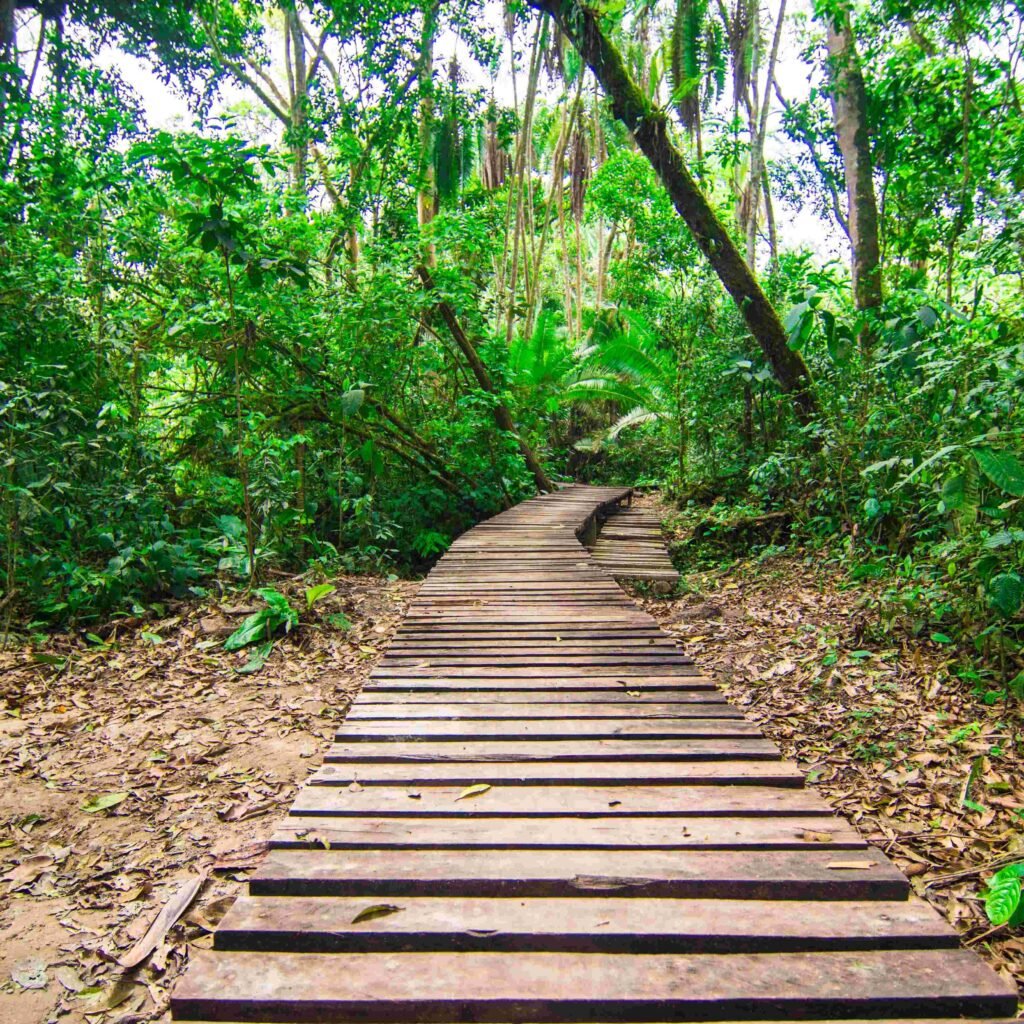
Chimpanzee tracking in Uganda is a thrilling and rewarding experience that will give you a deeper appreciation of these amazing creatures and their forest home. However, it is not an easy walk in the park. It requires physical fitness, patience, and respect for the wildlife and the environment. Here are some tips and information to help you plan your chimpanzee tracking adventure in Uganda.
Introduction to Uganda: The Pearl of Africa
Uganda is a landlocked country in East Africa that borders Kenya, Tanzania, Rwanda, South Sudan, and the Democratic Republic of Congo. It covers an area of 241,038 square kilometers (93,065 square miles) and has a population of about 45 million people. Uganda is known for its diverse and scenic landscapes, ranging from snow-capped mountains to lush rainforests to savannah plains to freshwater lakes. It has a tropical climate with two rainy seasons (March-May and September-November) and two dry seasons (December-February and June-August).
Uganda is also blessed with a rich and unique wildlife heritage. It hosts more than half of the world’s remaining mountain gorillas, as well as other endangered species such as rhinos, elephants, lions, leopards, cheetahs, giraffes, zebras, hippos, crocodiles, and antelopes. It has over 1,000 bird species, making it one of the best birding destinations in Africa. It also has 13 primate species, including chimpanzees, golden monkeys, red colobus monkeys, black-and-white colobus monkeys, blue monkeys, red-tailed monkeys, grey-cheeked mangabeys, vervet monkeys, baboons, bushbabies, and pottos.
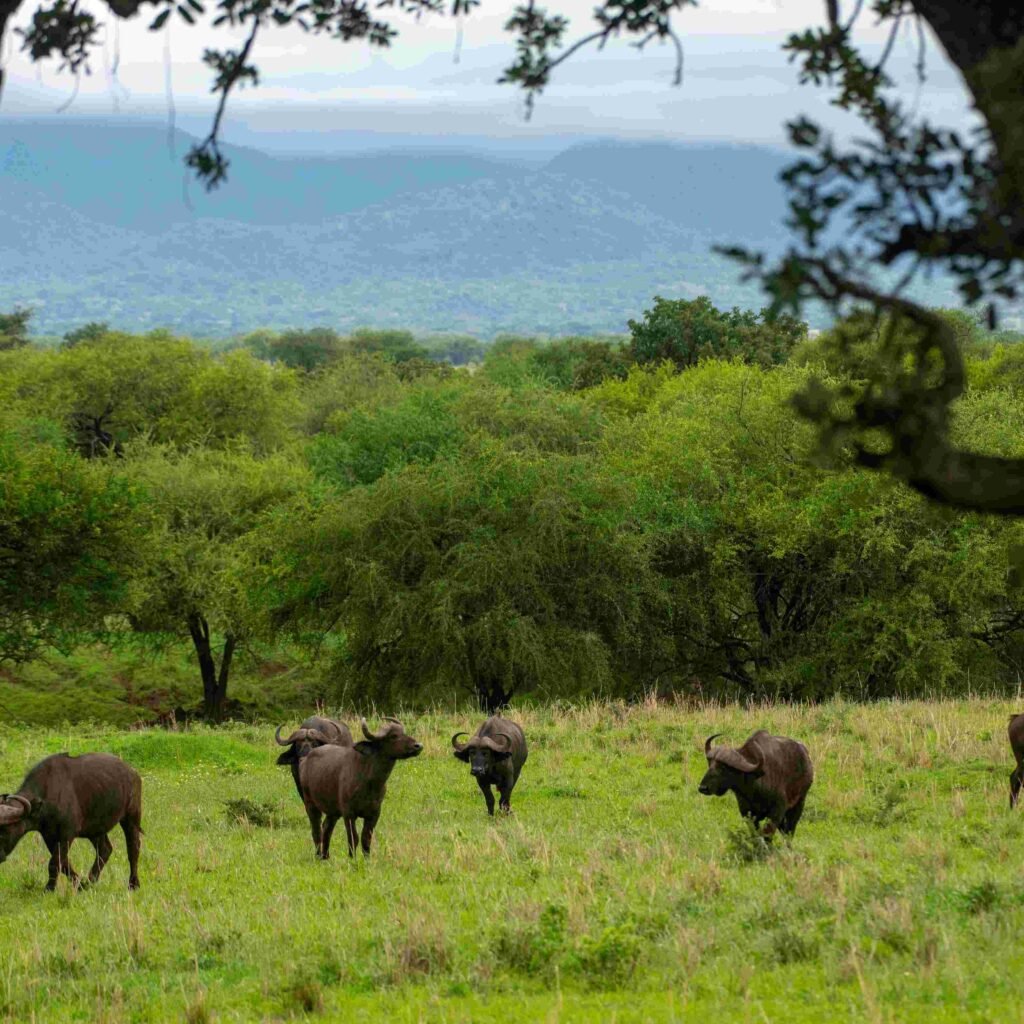
Uganda has been dubbed as the “Pearl of Africa” by Winston Churchill for its natural beauty and diversity. It is a country that offers something for every traveler, whether you are interested in culture, history, adventure, or relaxation. You can explore its vibrant cities such as Kampala and Entebbe; visit its historical and cultural sites such as the Kasubi Tombs and the Uganda Museum; enjoy its outdoor activities such as rafting on the Nile River and hiking on Mount Elgon; or relax on its islands such as Ssese Islands and Ngamba Island.
Where to Track Chimps in Uganda
Uganda has several national parks and forests where you can track chimpanzees. Each location has its own characteristics and attractions that make it worth visiting. Here are some of the most popular places for chimpanzee tracking in Uganda:
Kibale National Park
Kibale National Park is the most popular destination for chimpanzee tracking in Uganda. It is located in western Uganda, about 320 km from Kampala. It covers an area of 795 sq km and has an elevation range of 1100 to 1600 meters above sea level. It is one of the most biodiverse forests in Africa, with over 350 species of trees and over 70 species of mammals. It is home to the largest population of chimpanzees in Uganda, with about 1500 individuals living in 13 habituated groups. It also hosts 12 other species of primates, such as red colobus monkeys, black-and-white colobus monkeys, grey-cheeked mangabeys, red-tailed monkeys, blue monkeys, L’Hoest’s monkeys, olive baboons, and bushbabies. In addition to primates, Kibale National Park has over 375 species of birds, such as the African grey parrot, the green-breasted pitta, the crowned eagle, and the great blue turaco.
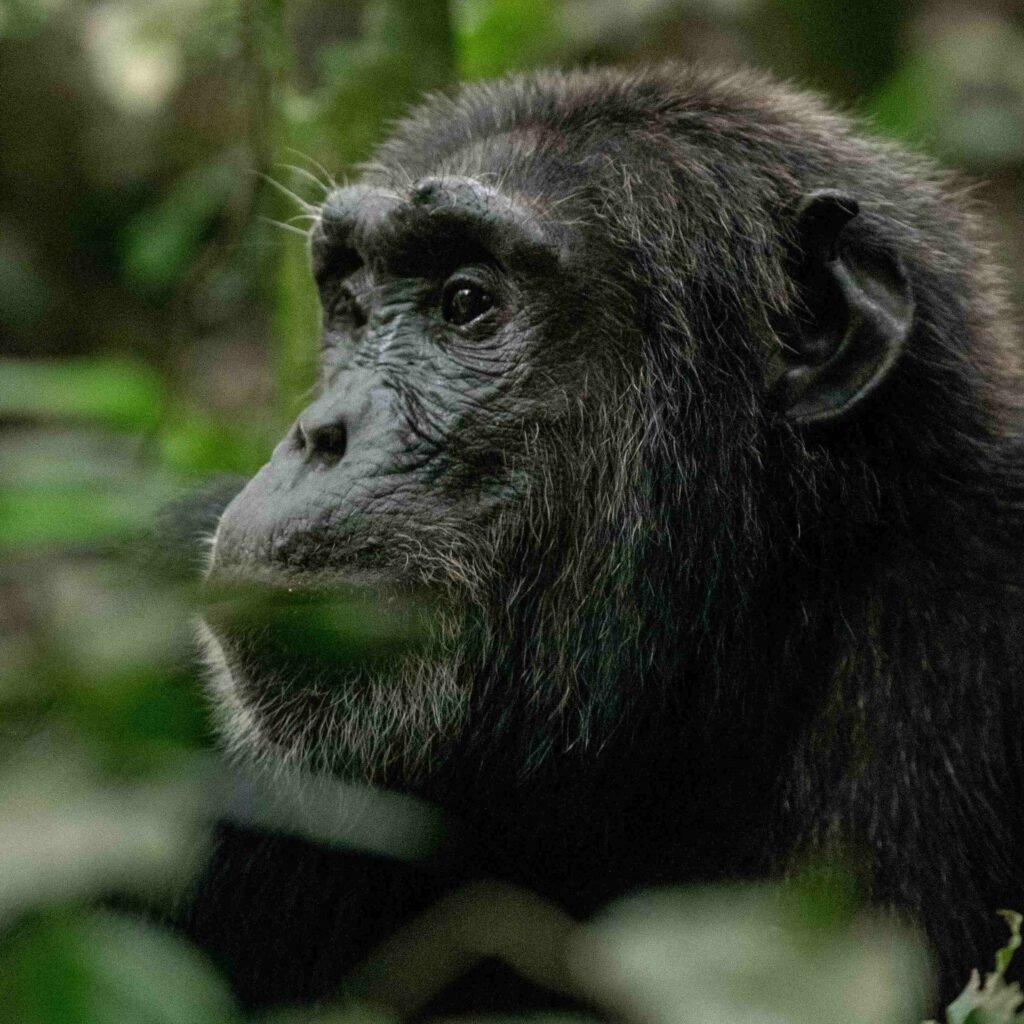
Kibale National Park offers two types of chimpanzee tracking experiences: chimpanzee trekking and chimpanzee habituation. Chimpanzee trekking is the standard activity that allows you to spend one hour with a habituated group of chimpanzees after finding them in the forest. Chimpanzee habituation is a more immersive activity that allows you to spend up to four hours with a semi-habituated group of chimpanzees that are still undergoing the process of getting used to human presence. Both activities start from Kanyanchu Visitor Centre at 8 am or 2 pm and last for 2 to 4 hours depending on the location of the chimpanzees..
Budongo Forest
This is another great place for chimpanzee tracking in Uganda. It is located in northwestern Uganda within the Murchison Falls National Park. It covers an area of 825 square kilometers (318 square miles) and has an average population of chimpanzees in Uganda. Budongo Forest has about 800 chimpanzees living in 6 habituated groups that are open for tourism. It also has other primates such as black-and-white colobus monkeys, blue monkeys, red-tailed monkeys, vervet monkeys, and baboons.
Budongo Forest has a dense tropical rainforest with tall mahogany trees and ironwood trees. It has over 360 bird species, including rare ones such as the puvel’s illadopsis and the yellow-footed flycatcher.
It also has other wildlife such as lions, leopards, hyenas, elephants, giraffes, and antelopes.
Kyambura Gorge
This is a hidden gem for chimpanzee tracking in Uganda. It is located in southwestern Uganda within the Queen Elizabeth National Park. It is a deep gorge that cuts through the savannah and is filled with lush vegetation and a river. It covers an area of 156 square kilometers (60 square miles) and has a small population of chimpanzees that are isolated from the rest of the park. Kyambura Gorge has about 20 chimpanzees living in one habituated group that is open for tourism. It also has other primates such as black-and-white colobus monkeys, red-tailed monkeys, vervet monkeys, and baboons. It has a unique habitat that contrasts with the surrounding landscape. It has over 200 bird species, including migratory ones such as the lesser flamingo and the greater flamingo. It also has other wildlife such as hippos, crocodiles, buffaloes, and elephants.
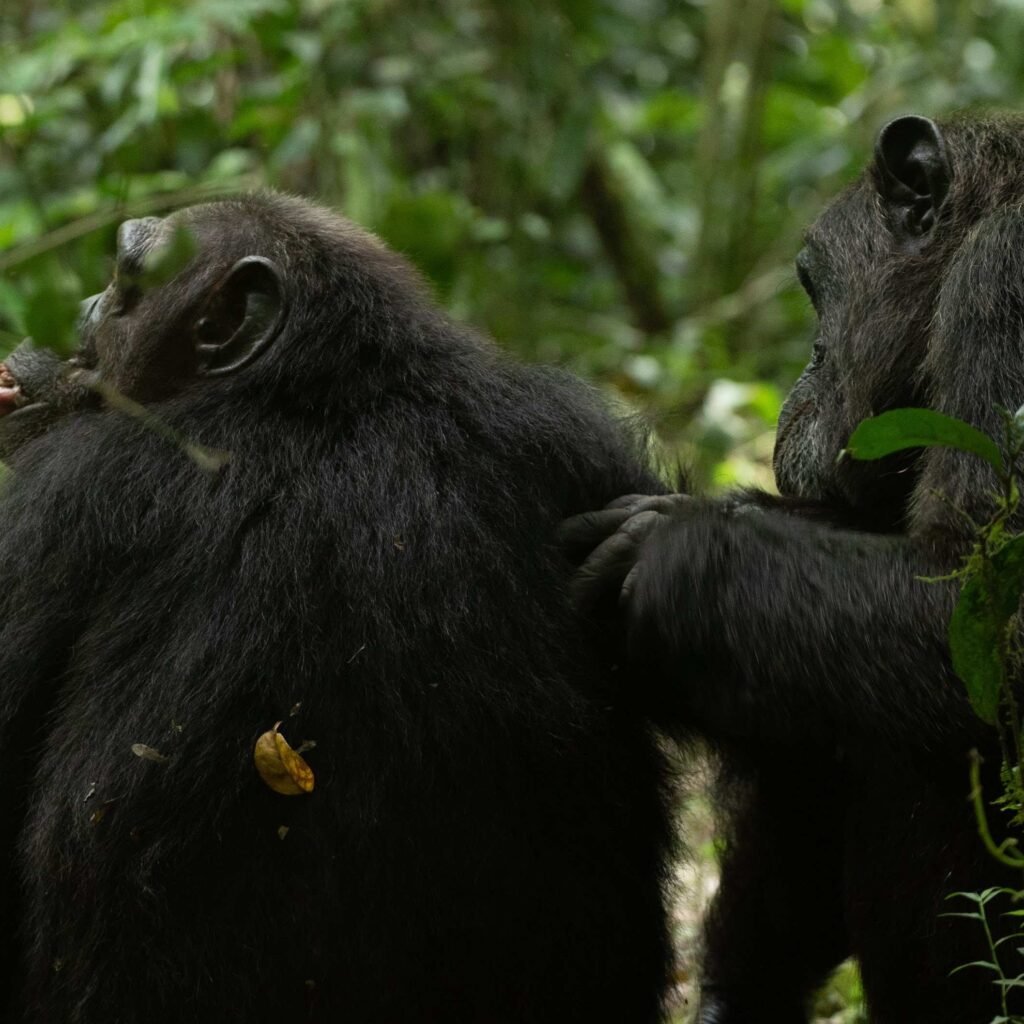
Chimpanzee Behavior and Biology
Chimpanzees are one of the most fascinating animals in the world. They are closely related to humans and share many similarities with us. They have complex social structures, high intelligence, and remarkable behaviors such as using tools, communicating with vocalizations, and expressing emotions. Here are some interesting facts about chimpanzees that you should know before tracking them:
- Chimpanzees belong to the genus Pan, which includes two species: the common chimpanzee (Pan troglodytes) and the bonobo (Pan paniscus). The common chimpanzee is found in 21 countries in West and Central Africa, while the bonobo is found only in the Democratic Republic of Congo. The two species are separated by the Congo River and differ in their appearance, behavior, and culture.
- Chimpanzees live in large communities that consist of several subgroups called parties. The parties can range from a few individuals to over 100 individuals, depending on the availability of food and mates. The parties are fluid and dynamic, meaning that they can change their size and composition frequently. The communities are based on male bonds, meaning that males stay in their natal group while females disperse to other groups when they reach maturity. The males form a dominance hierarchy that determines their access to resources and females. The females form temporary alliances with other females or males for protection and support.
- Chimpanzees are omnivorous, meaning that they eat both plants and animals. They mainly feed on fruits, leaves, seeds, nuts, flowers, and insects. They also hunt and eat meat, such as monkeys, antelopes, pigs, and rodents. They use various tools to obtain food, such as sticks to dig out termites, stones to crack nuts, leaves to sponge water, and spears to stab bushbabies.
- Chimpanzees communicate with each other using a range of vocalizations, gestures, facial expressions, and body postures. They have different calls for different purposes, such as alarm calls, food calls, greeting calls, and mating calls. They also use gestures such as pointing, waving, clapping, hugging, and kissing to convey their intentions and emotions. They can recognize themselves in mirrors and have a sense of self-awareness.
- Chimpanzees have a long lifespan that can reach up to 50 years in the wild and 60 years in captivity. They reach sexual maturity at around 8-10 years for females and 12-15 years for males. They have a gestation period of about 8 months and give birth to one offspring at a time. They have a strong mother-infant bond that lasts for several years. The infants depend on their mothers for food, protection, and learning until they are weaned at around 4-5 years.
Chimpanzee Tracking Experience in Uganda
Chimpanzees are one of the closest relatives of humans, sharing about 98% of our DNA. They are also highly intelligent, social, and expressive animals that have their own culture, language, and personality. Tracking chimpanzees in Uganda gives you the opportunity to witness their fascinating behavior and learn more about their complex lives.
Chimpanzee tracking involves following a group of habituated chimpanzees, which means they are used to human presence and will not run away or attack. You will be accompanied by a trained guide who will help you locate the chimps and explain their habits and characteristics. You will also have a ranger who will ensure your safety and respect for the wildlife.

The best part of chimpanzee tracking in Uganda is that you never know what you will see or hear. You might encounter the chimps feeding on fruits, leaves, or insects, grooming each other, playing, resting, or even hunting. You might also hear their loud and distinctive calls, such as pant-hoots, screams, or drumming on tree trunks. The experience is thrilling, educational, and emotional at the same time.
Other Wildlife Encounters
Chimpanzee tracking in Uganda is not only about the chimps. It is also a great way to explore the rich biodiversity of Uganda’s forests, where you can find many other wildlife species. Depending on where you go for chimpanzee tracking, you might spot some of the following animals:
- Monkeys: Uganda is home to 13 species of primates, including monkeys such as colobus, vervet, blue, red-tailed, L’Hoest’s, and golden monkeys. They are often seen jumping from tree to tree or feeding on fruits and flowers.
- Birds: Uganda is a birdwatcher’s paradise, with over 1000 species of birds recorded in the country. Some of the colorful and exotic birds you can see in the forests include turacos, hornbills, kingfishers, bee-eaters, sunbirds, weavers, and flycatchers.
- Forest-dwelling animals: Besides primates and birds, you can also encounter some of the mammals that live in the forests, such as elephants, buffaloes, antelopes, bush pigs, duikers, civets, mongooses, and porcupines.
Trekking and Hiking
Chimpanzee tracking in Uganda is not only a wildlife experience but also a physical challenge. It involves trekking and hiking through dense and hilly forests, sometimes on steep and slippery trails. The duration and difficulty of the activity depend on several factors, such as the location of the chimps, the weather conditions, and your fitness level.
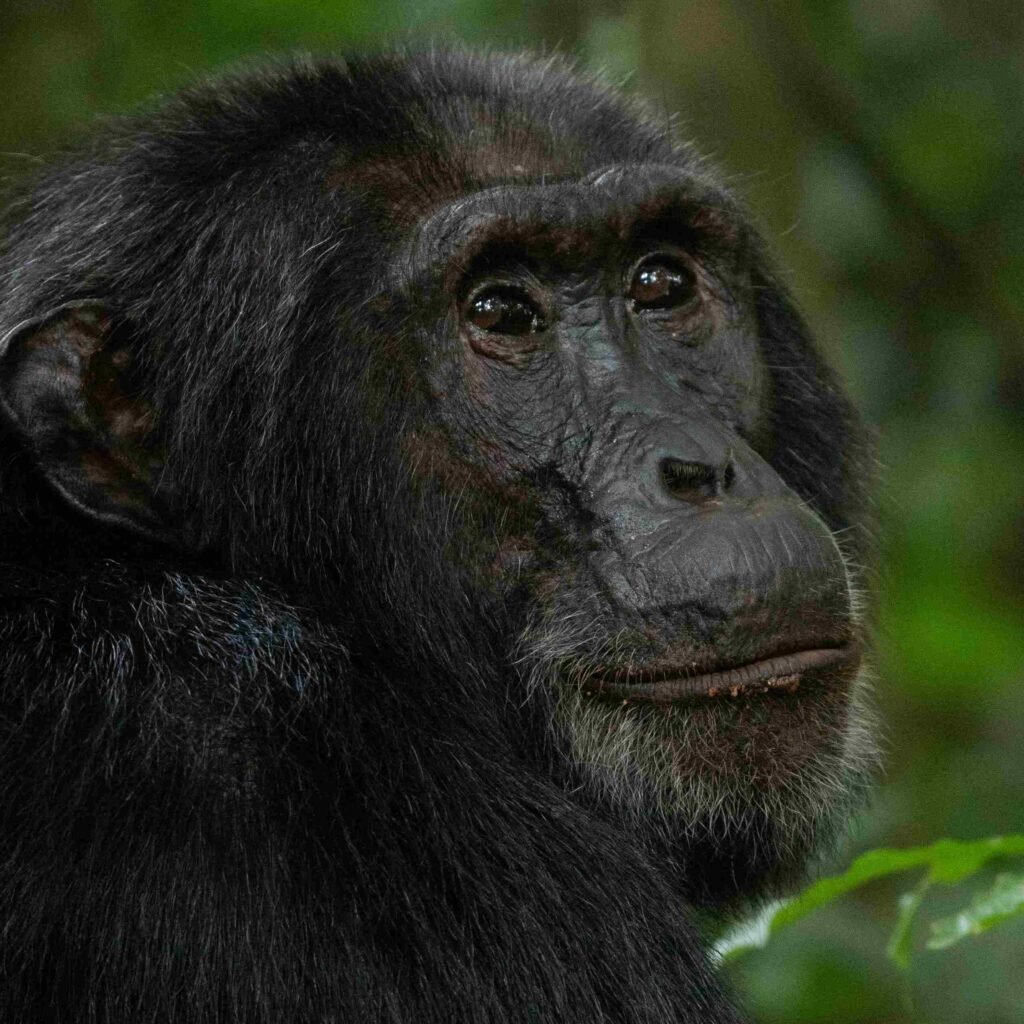
The average time for chimpanzee tracking is between 2 to 4 hours, but it can be shorter or longer depending on how lucky you are. You will usually spend one hour with the chimps once you find them. However, this is not guaranteed as the chimps are wild and free to move as they please.
Preparing for Chimpanzee Tracking in Uganda
To enjoy chimpanzee tracking in Uganda, you need to be in good physical shape and have some stamina and endurance. You also need to wear appropriate clothing and footwear for the forest environment. Some of the items you should bring include:
- Long-sleeved shirt and trousers to protect yourself from scratches and insect bites
- Hiking boots or shoes with good grip and ankle support
- Rain jacket or poncho in case of rain
- Hat or cap to shield yourself from the sun
- Gloves to protect your hands from thorns and nettles
- Binoculars and camera to capture the wildlife
- Water and snacks to keep yourself hydrated and energized
You also need to follow some rules and guidelines when doing chimpanzee tracking in Uganda. These include:
- Booking your chimpanzee tracking permit in advance as they are limited and sell out quickly
- Arriving at the park headquarters early in the morning for a briefing by your guide
- Keeping a distance of at least 7 meters from the chimps to avoid disturbing them or transmitting diseases
- Not using flash photography or making loud noises when near the chimps
- Not eating or drinking when near the chimps
- Not touching or feeding the chimps
- Not littering or damaging the forest
Responsible Tourism
Chimpanzee tracking is one of the most popular and rewarding activities for visitors to Uganda, offering a unique opportunity to observe these endangered primates in their natural environment. However, chimpanzee tracking also comes with some responsibilities and challenges, as these animals are highly vulnerable to human disturbance, disease, and habitat loss. Below, we discuss some useful information and tips on how to enjoy chimpanzee tracking in Uganda while minimizing your impact on the environment and the local communities.
Conservation Efforts:
Uganda is one of the few countries in Africa that has a national policy and strategy for the conservation of great apes, including chimpanzees. The country has designated several protected areas where chimpanzee populations are monitored and managed by the Uganda Wildlife Authority (UWA), in collaboration with various local and international partners. Some of these protected areas are:
- Kibale National Park: Kibale National Park is a hotspot for research and conservation of chimpanzees, with several ongoing projects led by institutions such as Makerere University, Max Planck Institute, and Kibale Chimpanzee Project. These projects aim to study the behavior, ecology, health, and genetics of chimpanzees, as well as to promote their conservation through education, community engagement, and alternative livelihoods.
- Budongo Forest: Budongo Forest Reserve is also a center for research and conservation of chimpanzees, with a long history of studies dating back to the 1960s. The Budongo Conservation Field Station (BCFS) is a leading institution that conducts research on chimpanzee behavior, ecology, health, and cognition, as well as providing training and education for students, researchers, and local communities.
- Kyambura Gorge: Kyambura Gorge is also a site for research and conservation of chimpanzees, with projects led by institutions such as Kyoto University and Kyambura Gorge Eco-Tourism Project (KGETP). These projects aim to monitor and protect the chimpanzees and their habitat, as well as to empower local communities through sustainable tourism development.
Local Communities and Culture
One of the benefits of chimpanzee tracking in Uganda is that it provides visitors with a chance to interact with local communities living near the chimpanzee habitats. These communities have coexisted with chimpanzees for generations, and have developed various traditions, customs, and livelihoods that reflect their relationship with nature. By visiting these communities, visitors can learn about their culture and history, as well as support their development and well-being.
Some examples of community-based activities that visitors can enjoy while chimpanzee tracking in Uganda are:
- Community walks: These are guided walks that take visitors through villages, farms, schools, and markets, where they can meet and interact with local people and learn about their daily lives and activities. Community walks also offer visitors an opportunity to experience the local cuisine, music, dance, and crafts, as well as to participate in some of the activities such as cooking, farming, or weaving.
- Cultural performances: These are shows that showcase the local talent and creativity of the communities, featuring traditional songs, dances, stories, and instruments. Cultural performances are usually organized by community groups or associations, such as women’s groups, youth groups, or cultural troupes. Cultural performances are a great way to appreciate the diversity and richness of the local culture, as well as to support the income and empowerment of the performers.
- Home stays: These are overnight stays that allow visitors to experience the hospitality and lifestyle of the local families. Home stays are usually arranged by community members who have spare rooms or houses that they can offer to visitors. Home stays are a great way to immerse oneself in the local culture and environment, as well as to build friendships and trust with the hosts.
Best Time to Track Chimps in Uganda
The best time to visit Uganda for chimpanzee tracking is during the dry seasons, which are from December to February and from June to September. During these periods, the weather is generally sunny and warm, and the trails are less muddy and slippery. The dry seasons also coincide with the peak seasons for tourism in Uganda, which means that you will have more chances of finding availability for accommodation, permits, and transportation.
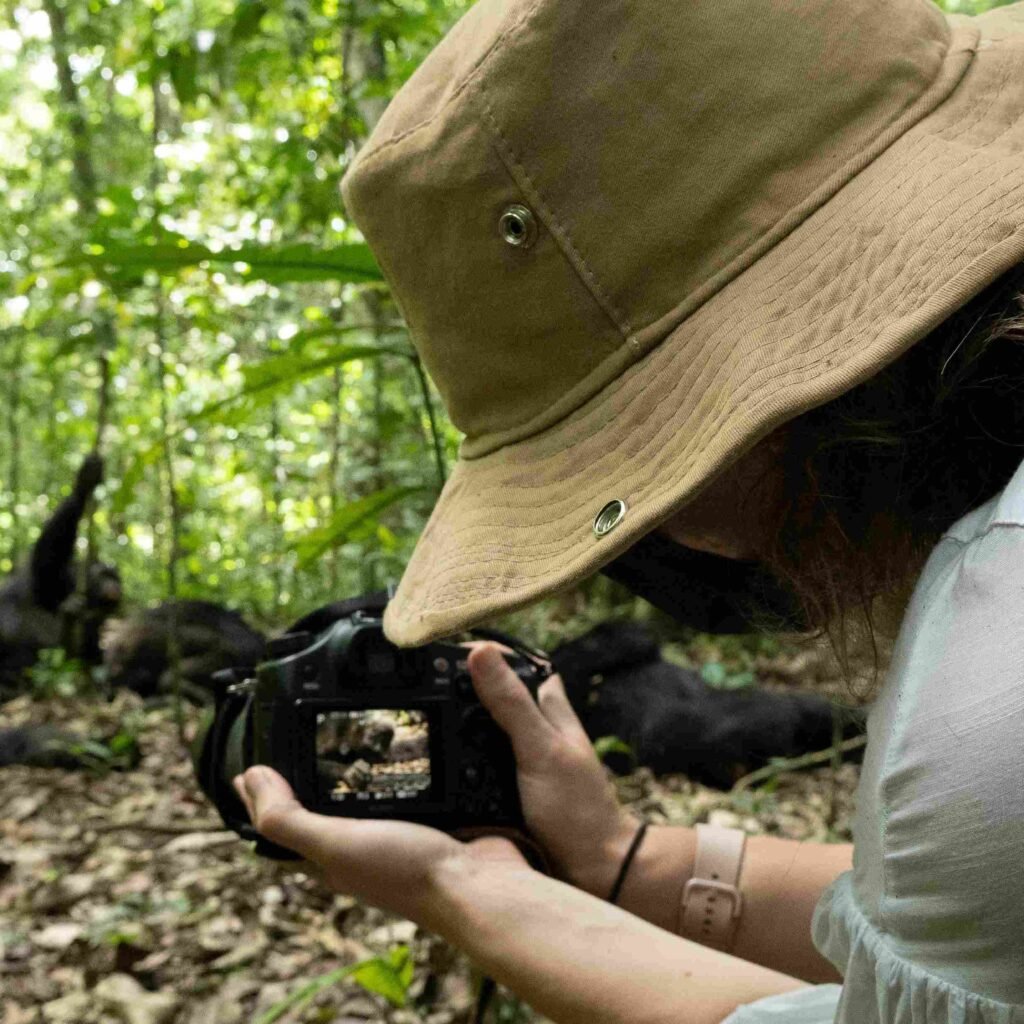
However, chimpanzee tracking can be done all year round, as the chimpanzees do not migrate and can be found in the forests throughout the year. The wet seasons, which are from March to May and from October to November, have some advantages as well. The rain makes the forests more lush and green, and the chimpanzees tend to stay closer to the ground, making them easier to spot. The wet seasons are also less crowded and cheaper, as there are fewer tourists and lower prices for accommodation and permits.
Safari Planning Tips
Planning a chimpanzee tracking safari in Uganda requires some preparation and research. Here are some practical advice to help you plan your trip:
Book your permits in advance
A chimpanzee tracking permit is a legal document that grants you access to a specific chimpanzee group in a specific forest for a specific date and time. The permits are issued by the Uganda Wildlife Authority (UWA) and are limited to a certain number per day per forest. The permits cost $200 per person per trek in Kibale National Park, $90 per person per trek in Budongo Forest Reserve, $50 per person per trek in Kalinzu Forest Reserve, and $50 per person per trek in Kyambura Gorge. The permits are valid for one hour of viewing the chimpanzees once you find them. You can book your permits directly through UWA or through a reputable tour operator. It is advisable to book your permits at least 3 months in advance, especially during the peak seasons, as they tend to sell out quickly.
Choose your destination
Uganda has several destinations where you can track chimpanzees, each with its own characteristics and attractions. The most popular destination is Kibale National Park, which has the highest concentration of chimpanzees in Africa and boasts a diversity of other primates and birds. Other destinations include Budongo Forest Reserve, which is part of Murchison Falls National Park and offers scenic views of the Nile River; Kalinzu Forest Reserve, which is near Queen Elizabeth National Park and has a rich cultural heritage; and Kyambura Gorge, which is a deep valley within Queen Elizabeth National Park and has a unique ecosystem. You can choose one or more destinations depending on your budget, time, and interests.
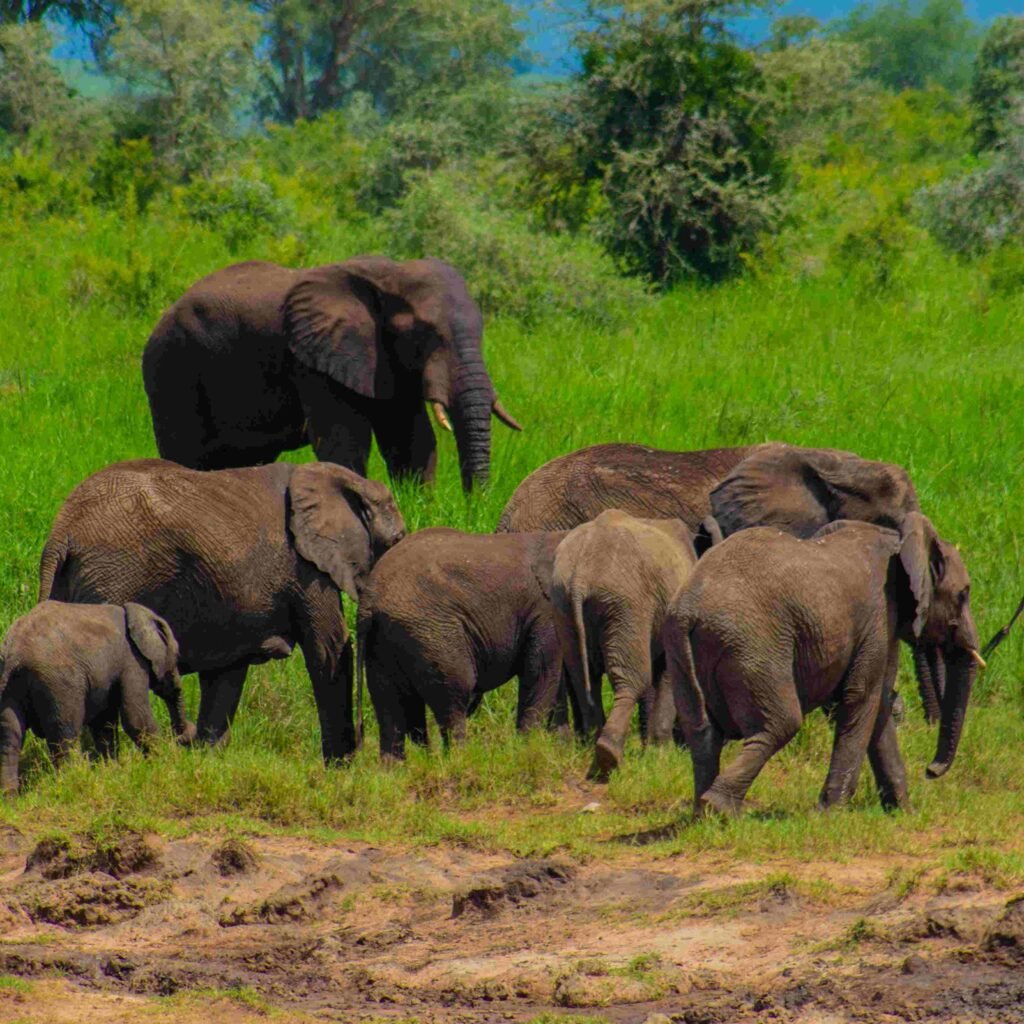
Arrange your transportation
Depending on your destination, you will need to arrange your transportation from Kampala or Entebbe (the main entry points to Uganda) to the forest where you will track the chimpanzees. You can either hire a private car with a driver or join a group tour with a safari company. The driving time varies from 4 hours to 8 hours depending on the destination and the road conditions. You can also opt for domestic flights from Entebbe to Kasese or Pakuba airstrips, which are near Kibale National Park and Murchison Falls National Park respectively. The flights take about 1 hour and cost around $300 per person one way.
Take health and safety precautions
Before traveling to Uganda, you should consult your doctor and get the necessary vaccinations and medications for malaria prophylaxis and yellow fever prevention. You should also carry insect repellent, sunscreen, first aid kit, and bottled water with you. While in Uganda, you should avoid drinking tap water, eating raw or uncooked food, and walking alone at night. You should also follow the instructions of your guides and rangers while tracking the chimpanzees, as they are wild animals and can be unpredictable and aggressive. You should also respect the local culture and customs of the people you encounter, and ask for permission before taking photos or videos of them.
Choose your accommodation
Uganda has a range of accommodation options to suit different budgets and preferences. You can choose from luxury lodges, mid-range hotels, budget guesthouses, or camping sites. Some of the accommodation options are located within or near the forests where you will track the chimpanzees, while others are in nearby towns or villages. You can book your accommodation online or through a tour operator. Some of the recommended accommodation options are:
- Kibale Forest Camp: A mid-range tented camp located in a private forest near Kibale National Park. It has 10 safari tents with en-suite bathrooms and private verandas. It also has a restaurant, a bar, and a lounge area. The camp offers chimpanzee tracking, chimpanzee habituation, and birdwatching activities. The rates are $140 per person per night for full board.
- Budongo Eco Lodge: A budget eco-lodge located in Budongo Forest Reserve. It has 5 cabins with shared bathrooms and 4 dormitory rooms with bunk beds. It also has a restaurant, a bar, and a library. The lodge offers chimpanzee tracking, chimpanzee habituation, forest walks, and birdwatching activities. The rates are $50 per person per night for full board.
- Kalinzu Forest Cottages: A budget guesthouse located near Kalinzu Forest Reserve. It has 6 cottages with private bathrooms and balconies. It also has a restaurant, a bar, and a garden. The guesthouse offers chimpanzee tracking, forest walks, and cultural tours. The rates are $30 per person per night for bed and breakfast.
- Kyambura Gorge Lodge: A luxury lodge located on the edge of Kyambura Gorge. It has 8 cottages with en-suite bathrooms and panoramic views. It also has a swimming pool, a spa, a restaurant, and a lounge area. The lodge offers chimpanzee tracking, game drives, boat cruises, and community projects. The rates are $490 per person per night for full board.
